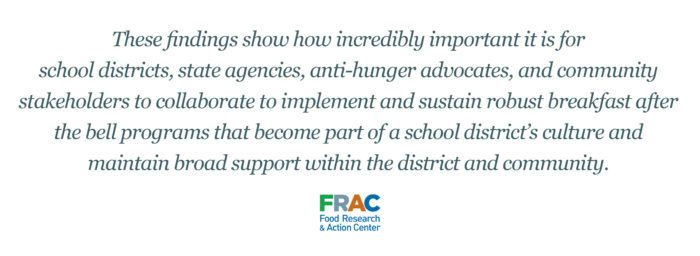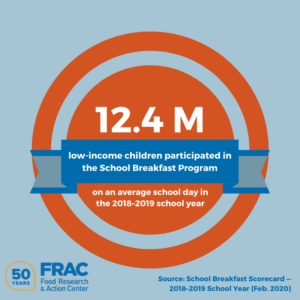February 13, 2020
During the 2018–2019 school year, 14.6 million children with 12.4 million of them from low-income families started the day right with a nutritious school breakfast, according to FRAC’s annual School Breakfast Scorecard, released today.
To drive program expansion, the report analyzes three measures of student participation — the number of low-income students participating, the total participation, and the number of low-income children participating in school breakfast, compared to their participation in school lunch—at the national and state levels.
- 12.4 million children received a free or reduced-price school breakfast on an average school day in the 2018–2019 school year. Participation remained relatively stable from the prior school year, with a nominal decrease of just 0.1 percent or just over 6,000 students.
- 14.6 million children ate breakfast at school on an average in the 2018-2019 school year. This was an increase of over 46,000 students from the previous school year.
- The School Breakfast Program served 57.5 low-income students for every 100 who participated in the National School Lunch Program, an increase from 56.9 to 100 in the prior school year. This increase in reach at a time when breakfast participation experienced a nominal decrease in participation was driven by the 200,000 student drop in school lunch participation among low-income students.
The flattening of school breakfast participation among low-income students, while overall participation in school breakfast grew, and the decrease in school lunch participation are due to a myriad of factors. These include a growing economy that is shrinking the number of low-income students and decreased school enrollment overall. Natural disasters also have impacted school nutrition operations in a few states.
In addition, there are more schools offering breakfast at no charge to all students (to decrease the stigma of school breakfasts being for “poor kids”) and implementing breakfast after the bell programs, which has helped drive the growth in overall school breakfast participation.
The national trends were not mirrored in every state. Some states continued to make gains, particularly when more schools implemented breakfast after the bell models and adopted the Community Eligibility Provision, which allows free breakfast and lunch to be offered to all students in high-poverty schools and districts. For the states that saw participation stall or decrease, it was often the consequence of some districts moving away from breakfast after the bell programs or the loss of stakeholder support within a district for expanding school breakfast participation.
FRAC has set an ambitious but achievable goal of reaching 70 low-income students who are certified to receive free or reduced-price school breakfast for every 100 who eat school lunch. West Virginia was the only state to meet and exceed FRAC’s goal in the 2018–2019 school year.
If all states met FRAC’s benchmark of reaching 70 low-income children with school breakfast for every 100 participating in school lunch, an additional 2.7 million low-income children would have started the day with a healthy breakfast at school. States and school districts would be able to use an additional $783.9 million in federal funding to support school food services and local economies.
Also released this week, FRAC’s School Breakfast: Making it Work in Large School Districts, a companion report to the School Breakfast Scorecard, examines School Breakfast Program participation rates and trends in 76 of the nation’s largest school districts. Of the 76 large school districts surveyed for this report, 23 achieved FRAC’s school breakfast benchmark, which was the result of broad implementation of breakfast after the bell programs and offering breakfast at no charge to all students. Los Angeles Unified School District (CA), San Antonio Independent School District (TX), and Newburgh Enlarged City School District (NY) remained the top-performing school districts for the third year in a row.
The findings of both reports demonstrate the positive impacts that best practices can have on increasing and expanding school breakfast participation. The U.S. Department of Agriculture, state child nutrition agencies, policymakers, educators, anti-hunger advocates, and other stakeholders can work together to move even more schools in the right direction and foster the broadened implementation of policies that will increase school breakfast participation. FRAC is committed to working with these important stakeholders to keep the momentum moving to ensure all students start the day with a healthy breakfast.




